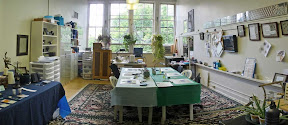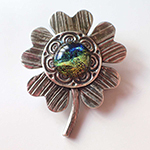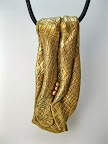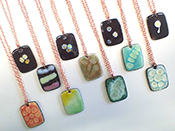Is it Metal, or Clay?
Sometimes, when a person is looking at one of my little creations, they will ask (often in a somewhat incredulous tone as they hold a hefty, solid piece), "Is this metal clay?"
The answer to that is tricky. Let me try to illustrate it with a few examples, then I’ll explain a bit more.
The correct answer often is, “No, it’s silver. Nothing more.”
 |
 |
| From CS’s Twists & Tubes | From CS’s Boxes |
Both those three spools-shaped beads and that little triangular box are composed of what is known as fine silver. That means they are at least 99.9% silver, as pure as you can get it. (The color on the surface, the patina, is added to the silver at the end of the finishing process to highlight certain areas of the design. But the patina can be quickly removed by polishing. In every other respect, those pieces are just silver.)
Here’s another example:
 |
| From CS’s Hollow Beads |
For the above piece, the answer would be, “Well, the big bead is fine silver. That is, solid silver. Nothing more, except for the little pink CZs (cubic zirconia)—there is one set on each side. And then it’s strung with some crystal and glass beads, on stainless steel wire with a sterling silver clasp.”
One more example:
 |
| From CS’s Brooches |
For that piece, the correct answer is, “The top part is fine silver. That is, solid silver. With some sterling silver added on the back to make it into a brooch, and some jasper, glass, and sterling silver beads dangled on it using some steel wire.”
But those answers all beg the question, “I thought you worked with metal clay.”
Well, yes, I do. But what you’re holding has no clay in it. Technically, it never had any clay at all. The fine silver part started out as a mix of tiny, tiny (micron sized) bits of pure powdered silver (almost like super-fine talc) mixed into an organic binder (mostly methyl cellulose, like plants have in their stalks, not like the clay that may be in the ground where plants grow). There’s also some water. That mix kind of feels like clay while you work with it.
But once I was done using clay-type techniques to shape the metal part, I let it dry out (so all the water would evaporate), and then burned off all the binder material. All of it. So I used “metal clay” techniques up to that point, after which the only thing that was left was silver. Pure, fine silver. On the brooch, I then used “traditional metalsmithing” techniques to add a sterling silver pin-part onto the back, and yet other techniques to add the glass and stone beads.
Which then prompts, “So this is now sterling silver?”
No, not really. Some people think sterling silver is all silver, but it’s not. The pin-finding on the back is sterling silver. Sterling is a mix of fine silver and copper plus, in some cases, other metals. (Argentium silver, for example, contains a bit of germanium in addition to the silver and copper and whatnot.) Mixing metals like that changes their properties a bit (the melting point, say, or how hard or soft they are, or how quickly their color darkens over time), which may matter to the maker as s/he tries to work the piece into shape, or to the products’ owners as they use them.
Like most of my pieces (to date, at least) the front of that brooch is all silver, what’s called fine silver. That means it’s pure silver, without anything else added in.
So, how does this piece relate to “metal clay”?
In my own mind, I think of “metal clay” as more a set of techniques that I use with silver that is in one particular state (one where it sort of resembles clay, so some pottery-type techniques can be applied) than I do as a product. Yes, I buy a product in that form to work with, but when I’m done, all someone else will ever see is the silver itself. When I have silver that’s in another state, I’ll use other techniques, such as those in the repertoire of metalsmiths, beaders, wireworkers, etc.
People have been converting metals back and forth among a whole variety of states for centuries. Fine silver can be converted into sterling by adding copper and more (to change its properties in various ways). It can be made into a relatively soft state (annealed) or a somewhat stiffer one (work-hardened). It can be milled into sheets or drawn out into wire. It can be polished to a bright shine or brushed to a satiny finish. A patina can be applied, to highlight certain areas of the design. Not illustrated in this simple discussion are a number of other ways to add color (through enamels or resins), as well as other ways to shape, texture, connect, and embellish pieces.
Metal clays are just relatively recent innovations in this stream of processes. They were developed by people who were, among other things, trying to figure out some good ways to use metals that could be reclaimed, such as from various photographic and manufacturing processes. Their metals were no longer in the solid “ore” state of traditional mining. They were, instead, often reduced to very small particles to begin with. How to use those?
Although “sintering” has been known for some time, in the mid to late 1990s, it was found that powders of silver and gold (two of the “precious” metals) could be mixed with a binder and water, in particular, and worked in that state. Later, the water is allowed to evaporate and the binder can be burned off. The remaining metal is heated some more, bringing it to nearly, but never over, its melting point. In the process of “sintering” the metal atoms then snuggle closer to each other, filling the space where the binder had been, and coalesce into a solid (well, almost solid but slightly porous) whole. Note what that means: pieces made using metal clay “shrink” as they are processed, which must be accounted for in the design stage.
A decade later, even more exploration has produced metal clays that use non-precious metals such as copper, bronze, and steel. The challenge with those was to discover ways to heat them such that the binder would burn off (a process that requires oxygen) while at the same time sintering to a nice shiny metal (which can be achieved in some non-precious metals by restricting exposure to oxygen that would, otherwise, turn them all black and ugly).
Yes, this is an exciting time to be working in metals!
 |
| From CS’s Twists & Tubes |

 Artsmiths of Pittsburgh
Artsmiths of Pittsburgh Hoyt Center for the Arts, New Castle, PA
Hoyt Center for the Arts, New Castle, PA Portage Hill Gallery, Westfield, NY
Portage Hill Gallery, Westfield, NY _Open Houses in my Studio
_Open Houses in my Studio _Or…contact me about hosting a private party!
_Or…contact me about hosting a private party!